Nursery Rhyme
Topic with 72 items
|
Title
|
Images
|
Item Comment
|
Prefix
|
Number
|
In set
|
Set
|
Set Comment
|
Type
|
Artist
|
Author
|
Size
|
Topics
|
Set Covers
|
Reference
| |
|---|---|---|---|---|---|---|---|---|---|---|---|---|---|---|---|
| 61 |
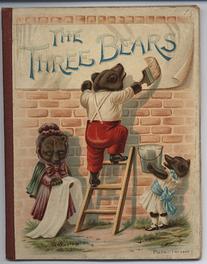

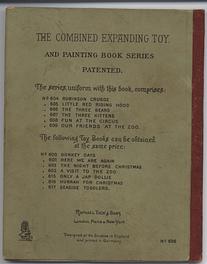
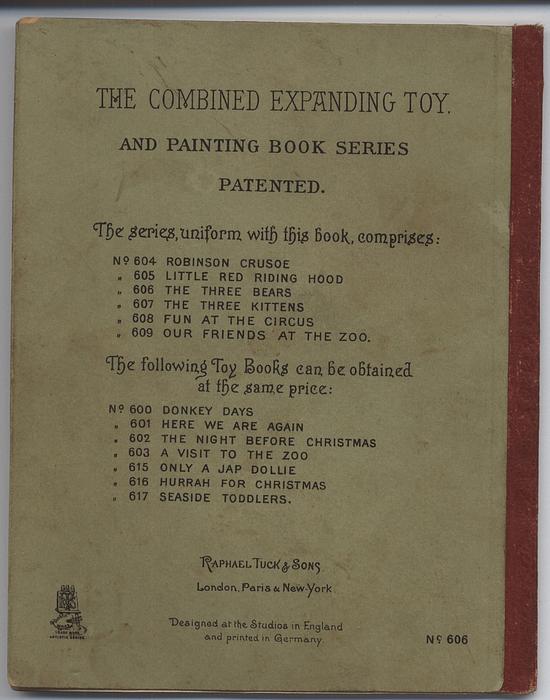
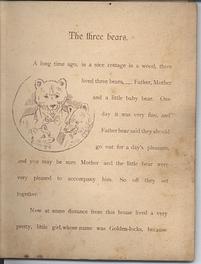

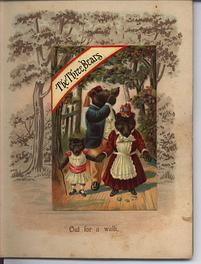

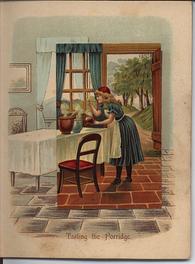
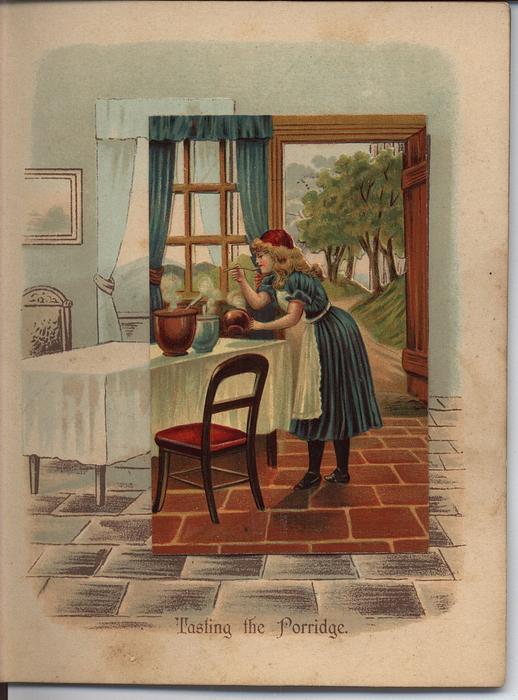
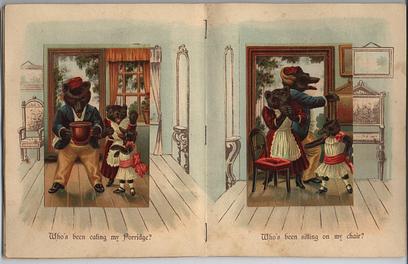

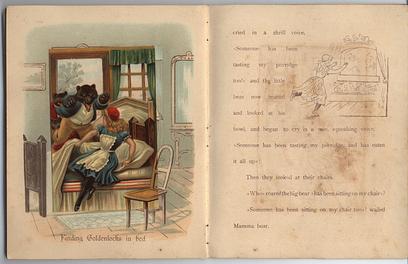
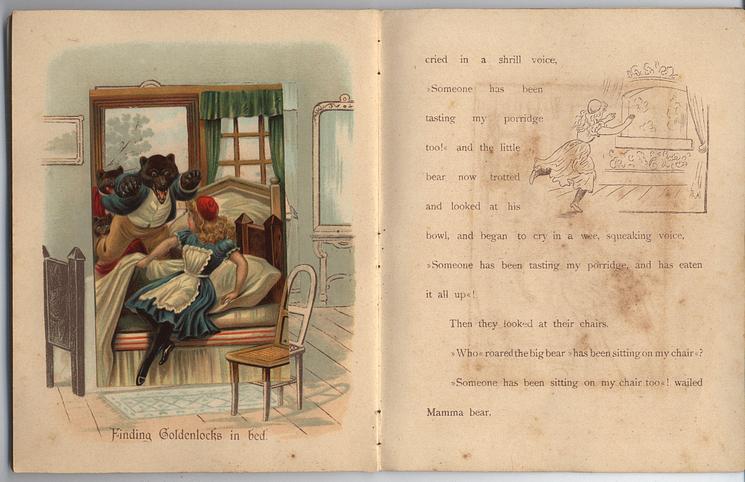
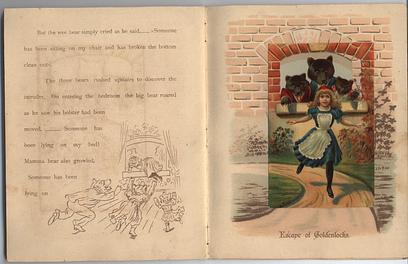

|
contains six individual panels from THE THREE BEARS scrap fold out panorama booklet number 26, 16 pages, front cover illustration and scrap panels also come in a folded greeting card titled THE THREE BEARS
|
|
606
|
|
A series of six story books with individual panels of relief scraps that are superimposed over brown line drawings and raised to give an expanding or pop up image. Inside front cover has a sticker with DIRECTIONS. TO SECURE DESIRED EFFECT, PUSH THE PICTURE TO THE RIGHT. DO NOT LIFT PICTURE. PATENT NO. 2444, RAPHAEL TUCK & SONS, LONDON, PARIS & NEW YORK. DESIGNED AT THE STUDIOS IN ENGLAND AND PRINTED IN GERMANY, easel RTS ARTISTIC SERIES trademark
|
|
|
14 x 18 cm
|
|
| ||||
| 62 |
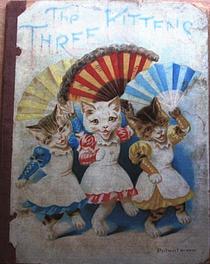
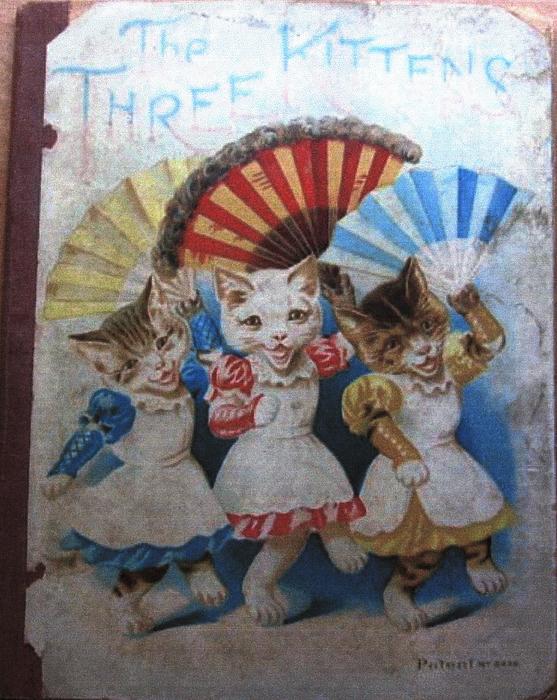
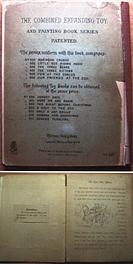
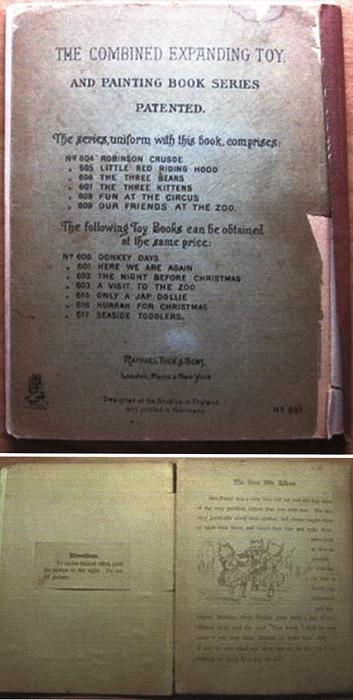
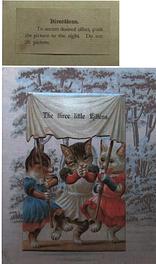
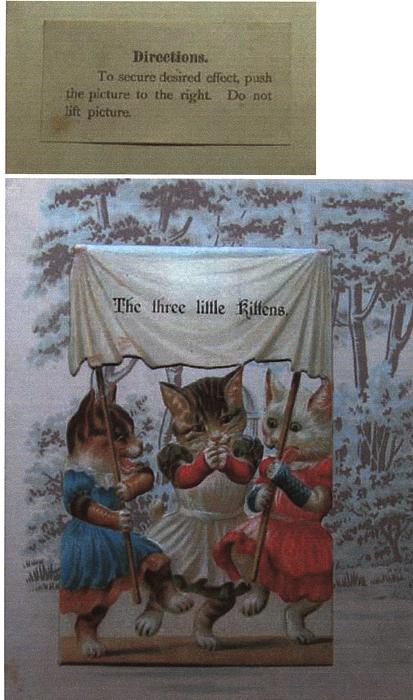

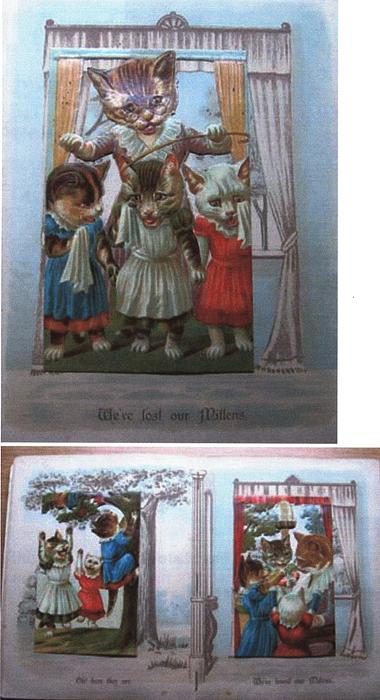
|
contains six individual panels from fold out panorama booklet THE THREE KITTENS number 25, 16 pages, also comes as a folded greeting card titled A HAPPY CHRISTMAS
|
|
607
|
|
A series of six story books with individual panels of relief scraps that are superimposed over brown line drawings and raised to give an expanding or pop up image. Inside front cover has a sticker with DIRECTIONS. TO SECURE DESIRED EFFECT, PUSH THE PICTURE TO THE RIGHT. DO NOT LIFT PICTURE. PATENT NO. 2444, RAPHAEL TUCK & SONS, LONDON, PARIS & NEW YORK. DESIGNED AT THE STUDIOS IN ENGLAND AND PRINTED IN GERMANY, easel RTS ARTISTIC SERIES trademark
|
|
|
14 x 18 cm
|
|
| ||||
| 63 |
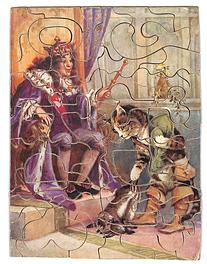



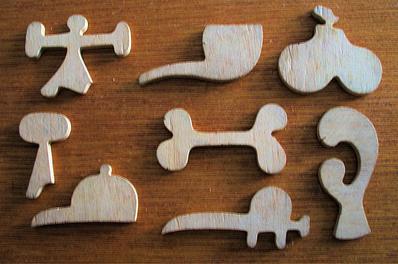

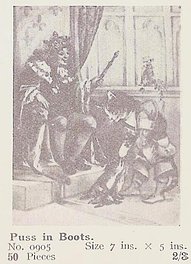
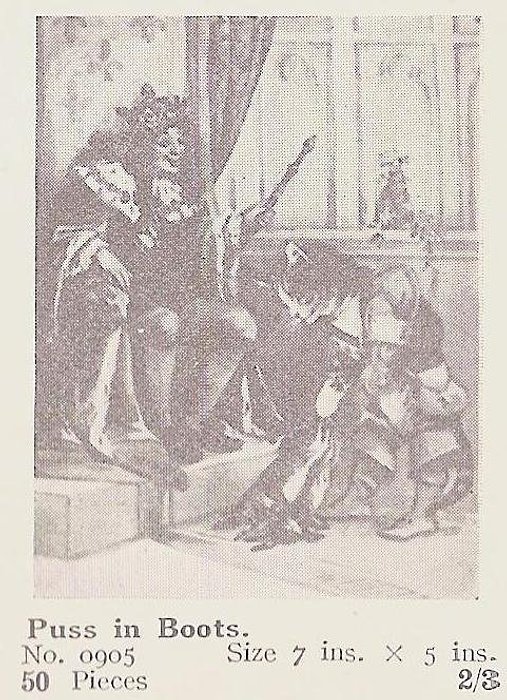
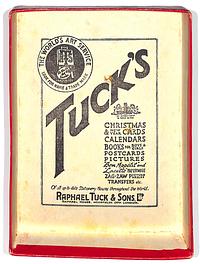

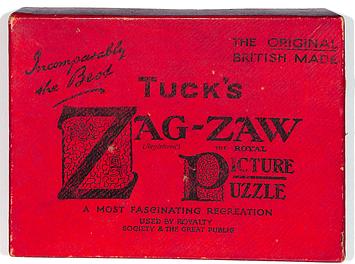

|
50 pieces, wooden, figurals, complete with box, push fit style, also comes with no number, pictured in catalog on page 31.
|
|
905
|
|
Zag-Zaw line of puzzles was first produced in 1909, most incorporate figurals or whimsies, sold in red, orange, or occasionally green boxes with labels on the side or bottom of the box, most without guide pictures. Initially cut non-interlocking but by 1930's became more so. Puzzles have a different cuts so that the same image will come in several versions which means that missing pieces can not be taken from other puzzles with the same image. The puzzle labels are often hand written and come with minor variations in titles and details. Some have a DESIGN catergory on the label. From my readings this refers to the style of cut, wavy lines, figurals, etc. See also Bob Armstrong's website on old jigsaw puzzles
|
M. BOWLEY
|
|
5 x 6 3/4 in.
|
|
| ||||
| 64 |

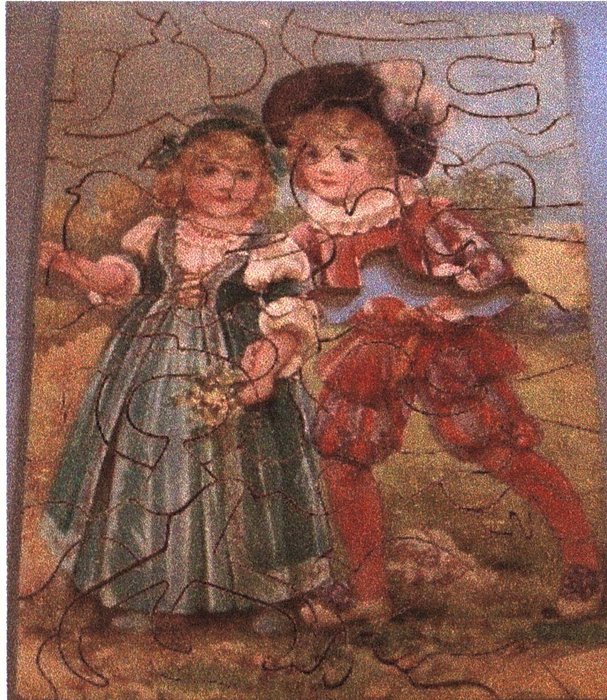
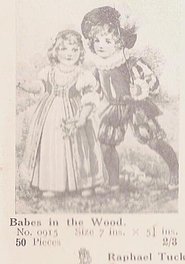

|
about 50 pieces, wooden, figurals, with box, push fit style, described and listed in the catalogs as number 0915
|
|
|
|
Zag-Zaw line of puzzles was first produced in 1909, most incorporate figurals or whimsies, sold in red, orange, or occasionally green boxes with labels on the side or bottom of the box, most without guide pictures. Initially cut non-interlocking but by 1930's became more so. Puzzles have a different cuts so that the same image will come in several versions which means that missing pieces can not be taken from other puzzles with the same image. The puzzle labels are often hand written and come with minor variations in titles and details. Some have a DESIGN catergory on the label. From my readings this refers to the style of cut, wavy lines, figurals, etc. See also Bob Armstrong's website on old jigsaw puzzles
|
|
|
5 1/4 x 7 in.
|
|
| ||||
| 65 |
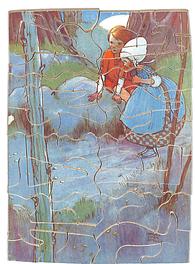
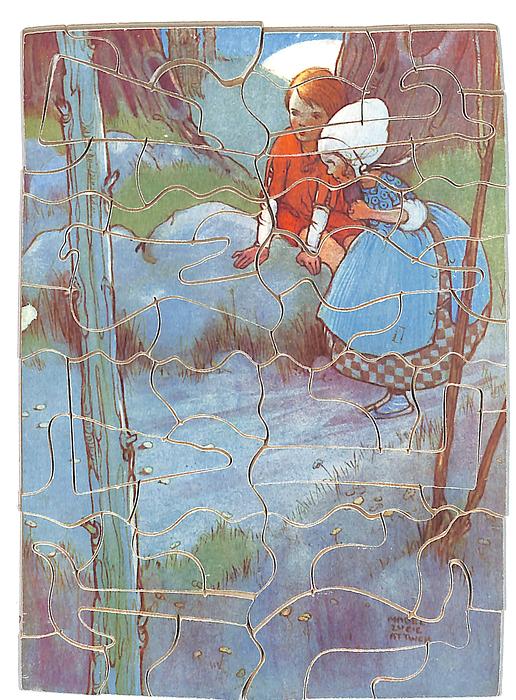
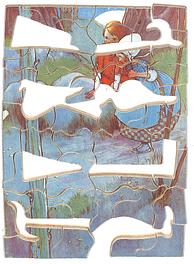
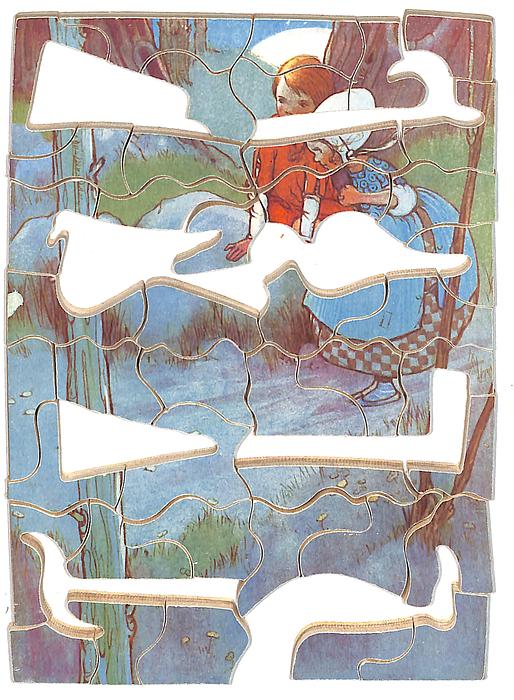
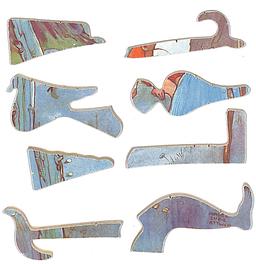

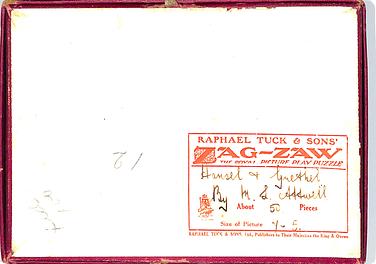
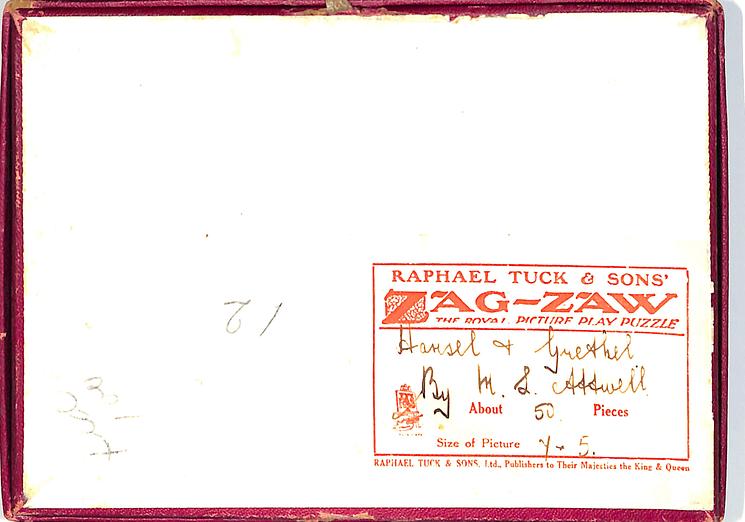
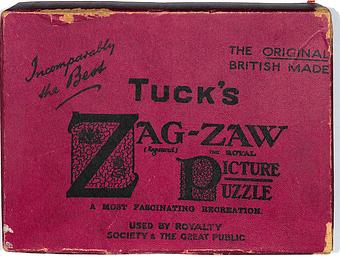
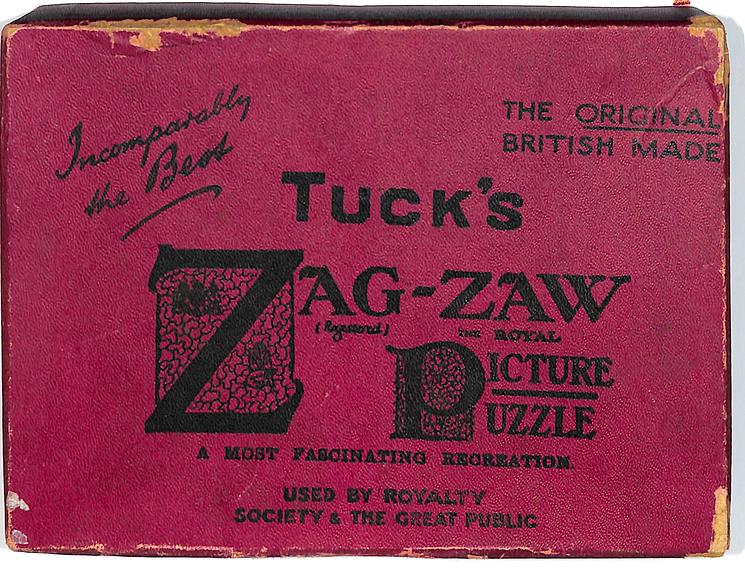

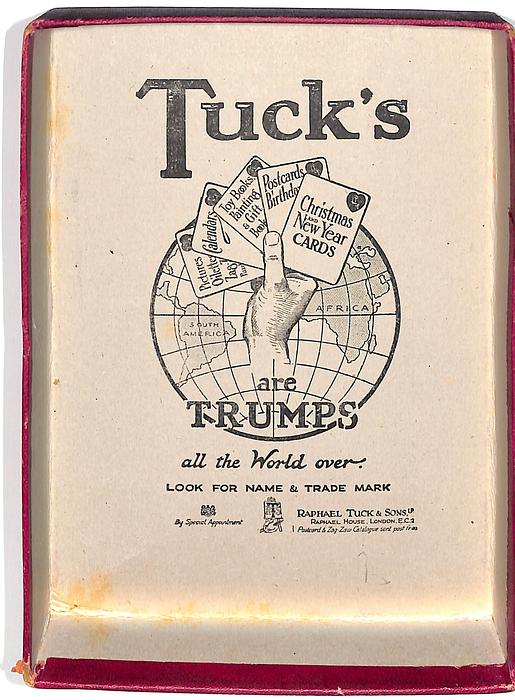
|
about 50 pieces, wooden, figurals, complete with box, push fit style, the same image also comes as Tuck postcard 4095
|
|
|
|
Zag-Zaw line of puzzles was first produced in 1909, most incorporate figurals or whimsies, sold in red, orange, or occasionally green boxes with labels on the side or bottom of the box, most without guide pictures. Initially cut non-interlocking but by 1930's became more so. Puzzles have a different cuts so that the same image will come in several versions which means that missing pieces can not be taken from other puzzles with the same image. The puzzle labels are often hand written and come with minor variations in titles and details. Some have a DESIGN catergory on the label. From my readings this refers to the style of cut, wavy lines, figurals, etc. See also Bob Armstrong's website on old jigsaw puzzles
|
M. L. ATTWELL (1879-1964)
|
|
5 x 7 in.
|
|
| ||||
| 66 |
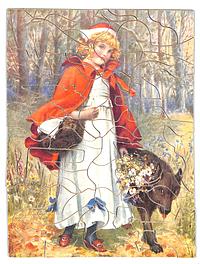

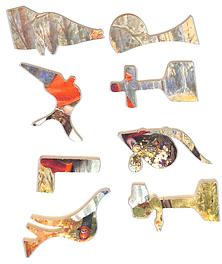
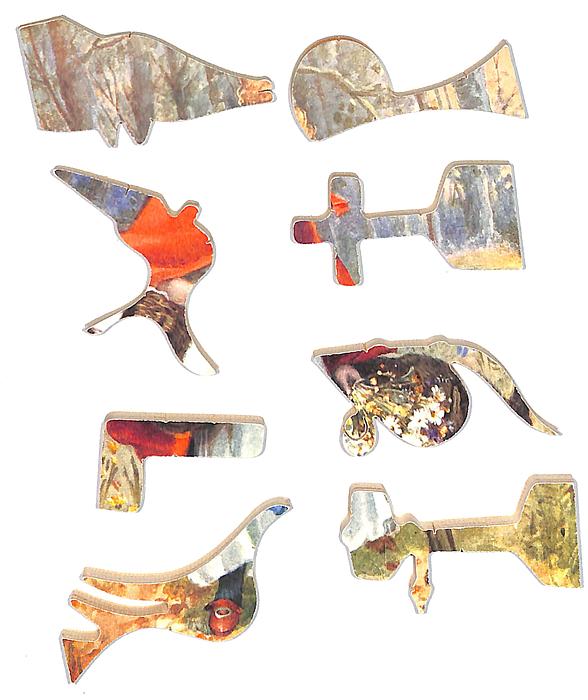
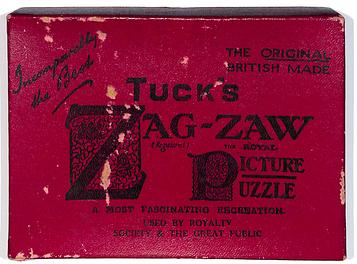


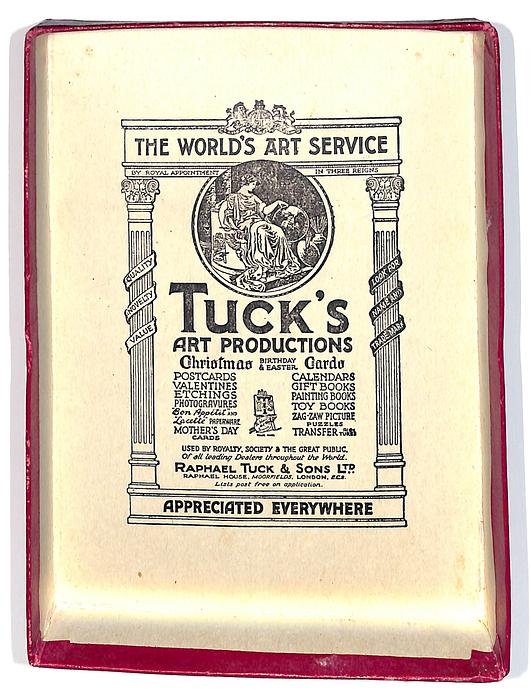
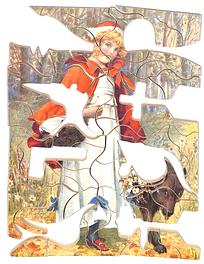
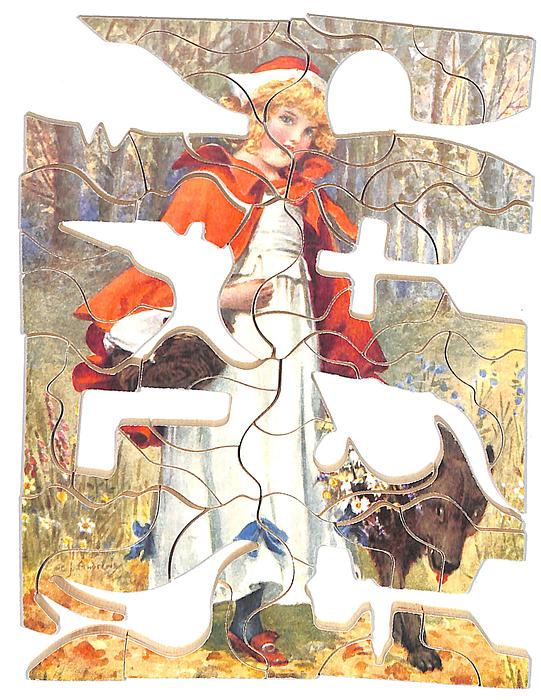
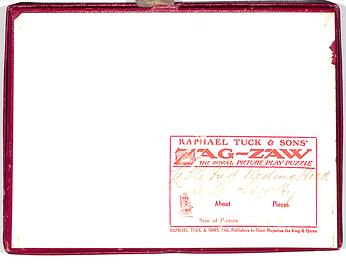
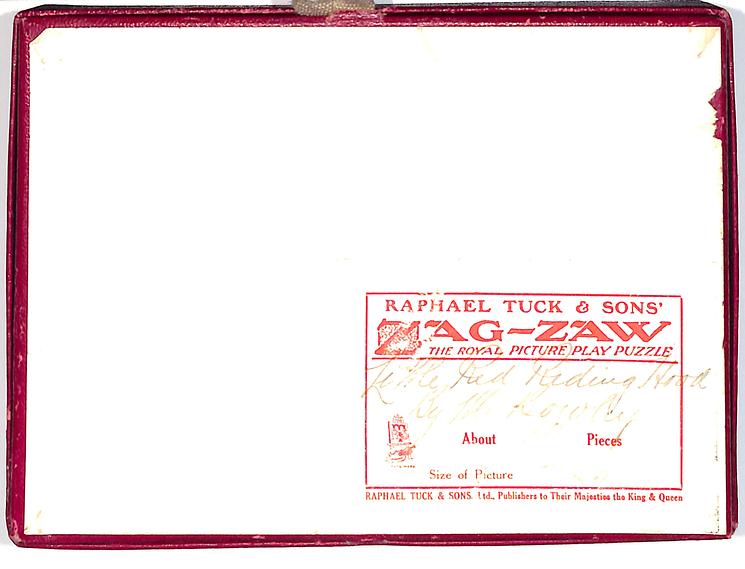
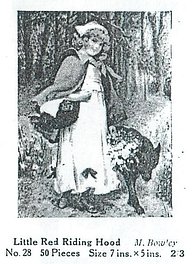
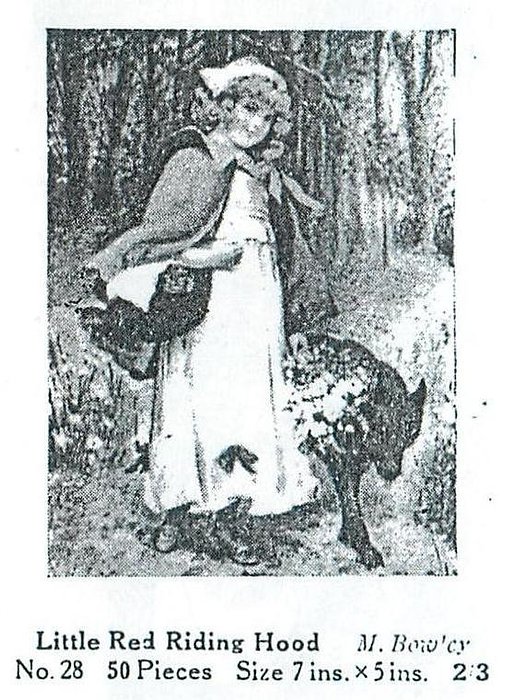
|
about 50 pieces, wooden, figurals, complete with box, described and listed in the catalogs and given the number 28, puzzle has a different artist signature than Bowley but the label and the catalogs list the artist as Bowley, the signature on the puzzle is Edith J. Andrews-see image
|
|
|
|
Zag-Zaw line of puzzles was first produced in 1909, most incorporate figurals or whimsies, sold in red, orange, or occasionally green boxes with labels on the side or bottom of the box, most without guide pictures. Initially cut non-interlocking but by 1930's became more so. Puzzles have a different cuts so that the same image will come in several versions which means that missing pieces can not be taken from other puzzles with the same image. The puzzle labels are often hand written and come with minor variations in titles and details. Some have a DESIGN catergory on the label. From my readings this refers to the style of cut, wavy lines, figurals, etc. See also Bob Armstrong's website on old jigsaw puzzles
|
H. BOWLEY (on label) puzzle is signed by Edith J. Andrews
|
|
5 x 7 in.
|
|
| ||||
| 67 |
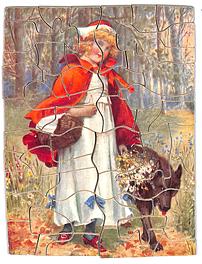

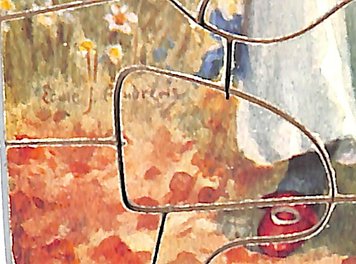
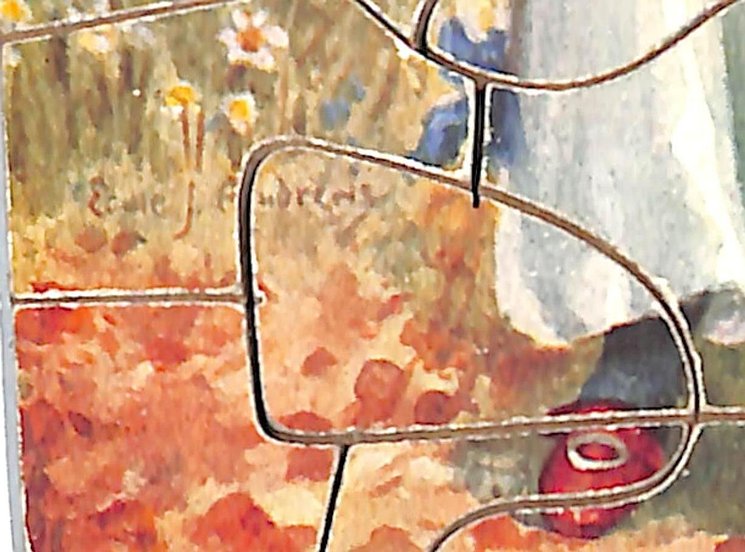
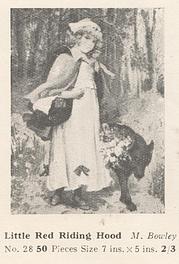
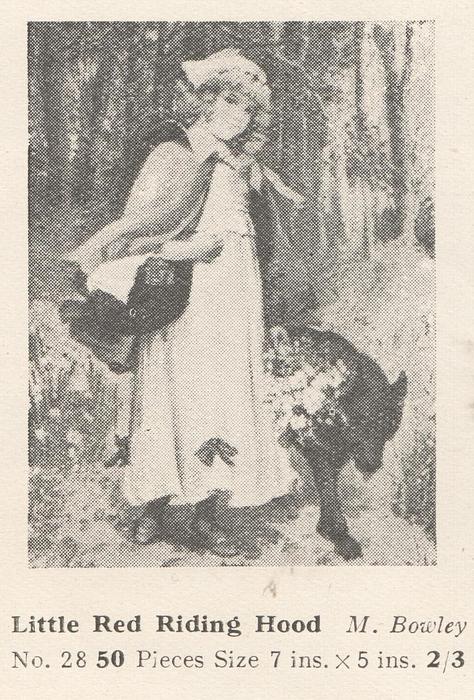

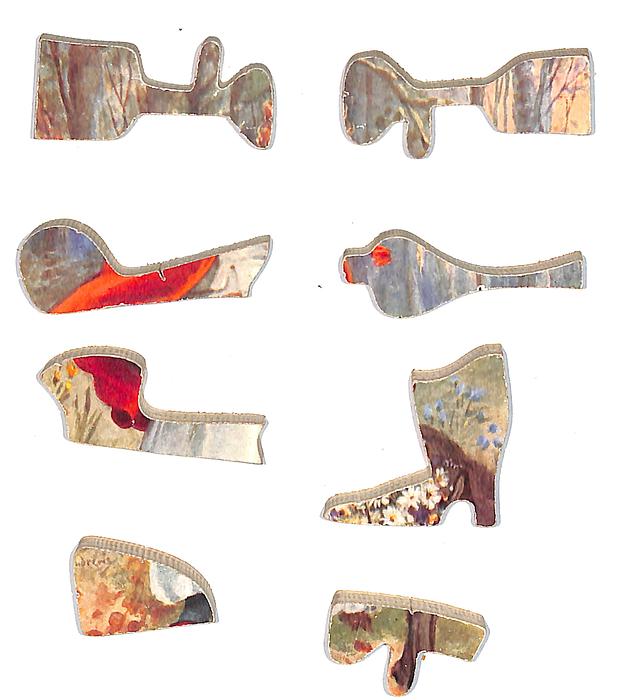
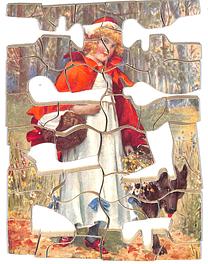
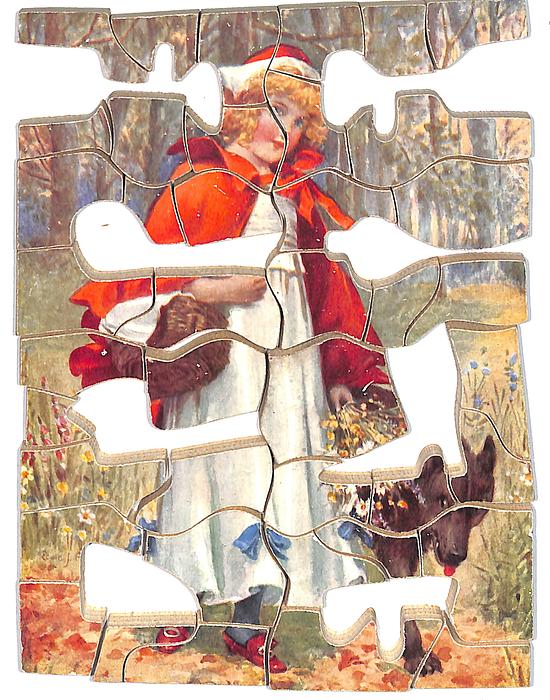
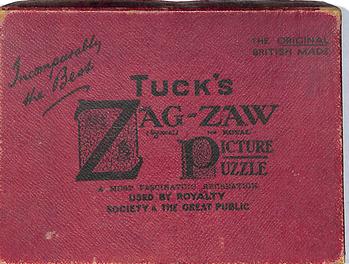
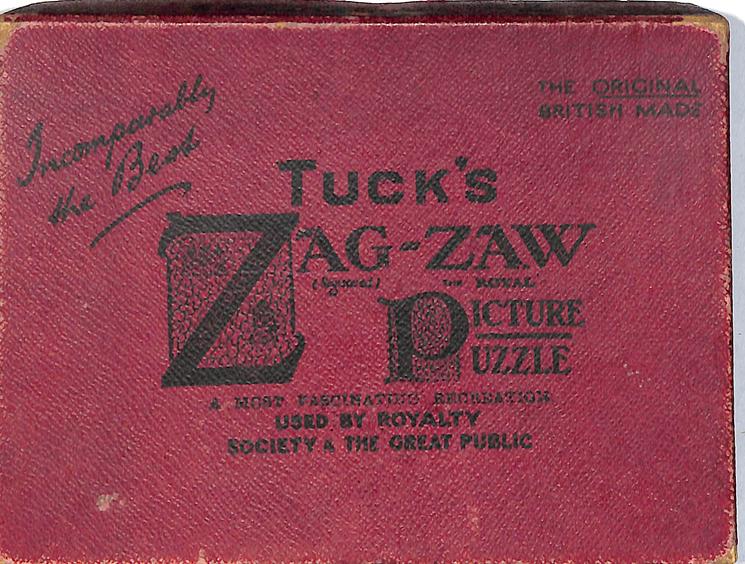
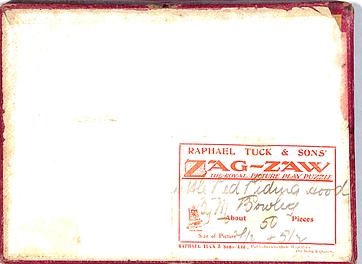
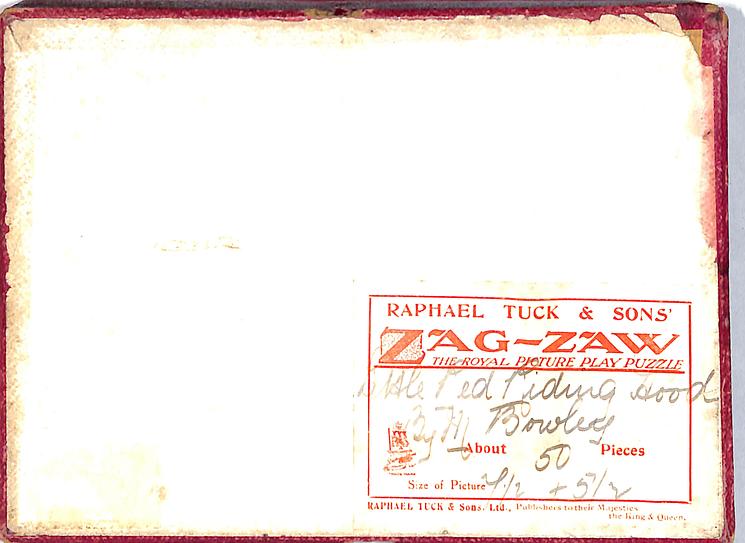
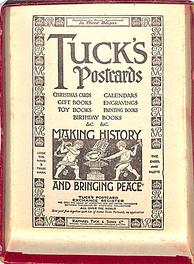

|
about 50 pieces, wooden, figurals, complete with box, described and listed in the catalogs and given the number 28, puzzle has a different artist signature than Bowley but the label and the catologs list the artist as Bowley, the signature on the puzzle is Edith J. Andrews-see image
|
|
|
|
Zag-Zaw line of puzzles was first produced in 1909, most incorporate figurals or whimsies, sold in red, orange, or occasionally green boxes with labels on the side or bottom of the box, most without guide pictures. Initially cut non-interlocking but by 1930's became more so. Puzzles have a different cuts so that the same image will come in several versions which means that missing pieces can not be taken from other puzzles with the same image. The puzzle labels are often hand written and come with minor variations in titles and details. Some have a DESIGN catergory on the label. From my readings this refers to the style of cut, wavy lines, figurals, etc. See also Bob Armstrong's website on old jigsaw puzzles
|
H. BOWLEY (on label) puzzle is signed by Edith J. Andrews
|
|
5 x 7 in.
|
|
| ||||
| 68 |
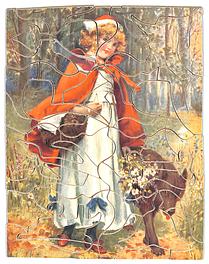

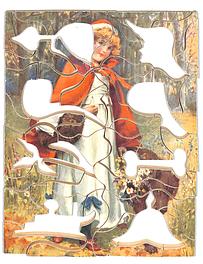
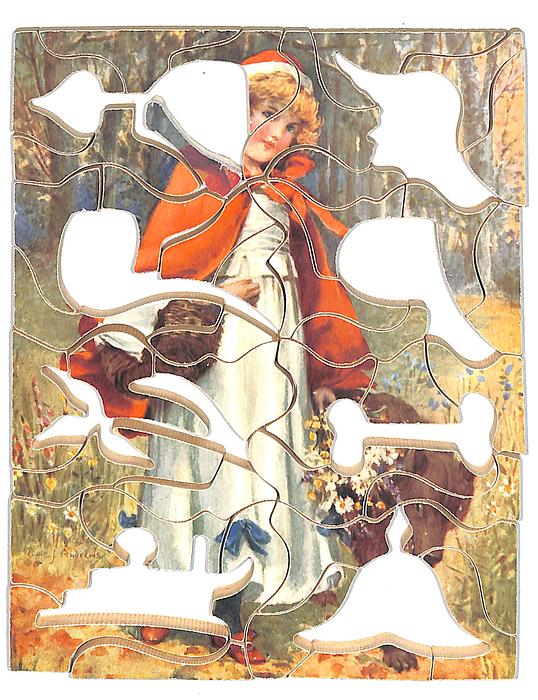
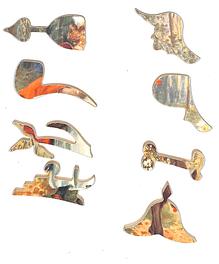
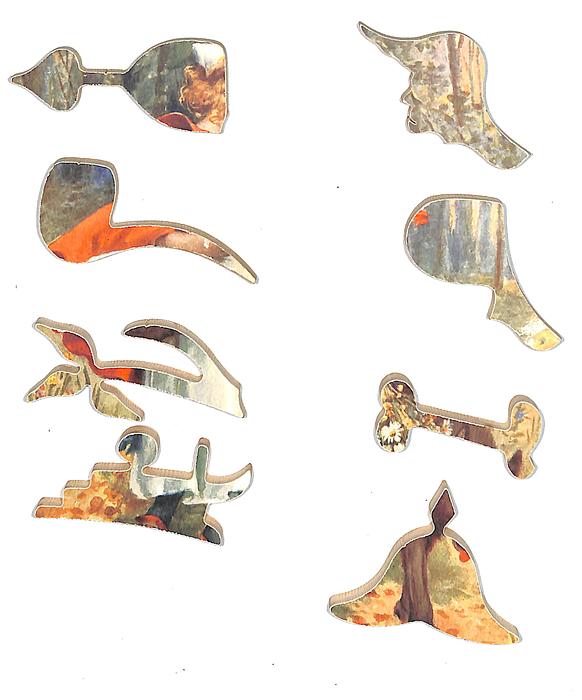
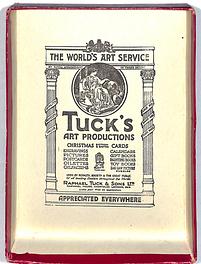
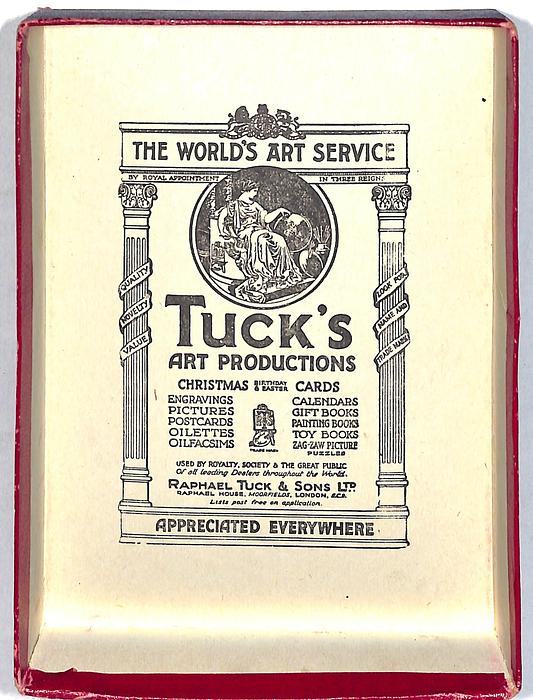
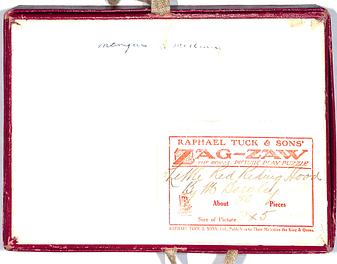
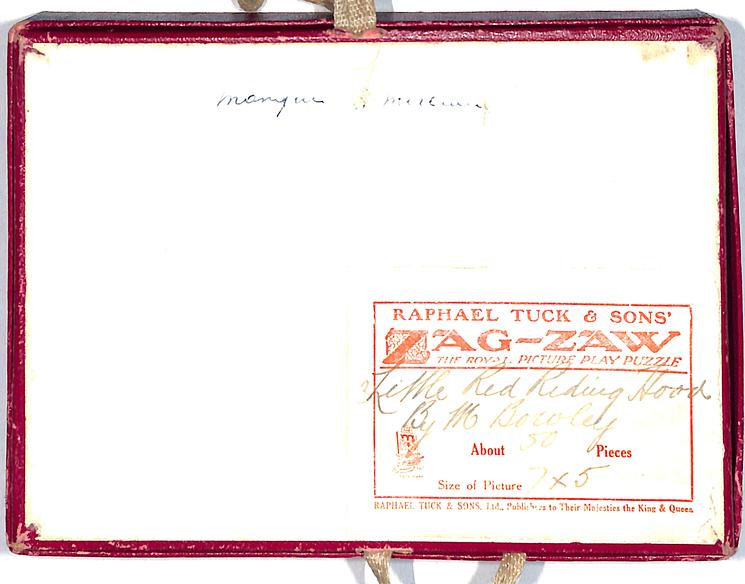
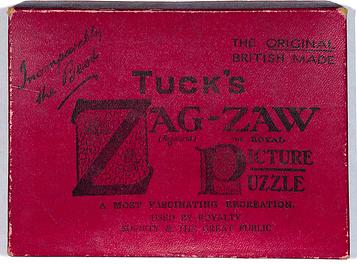

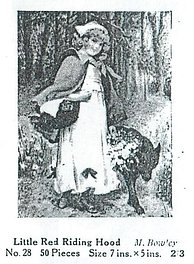
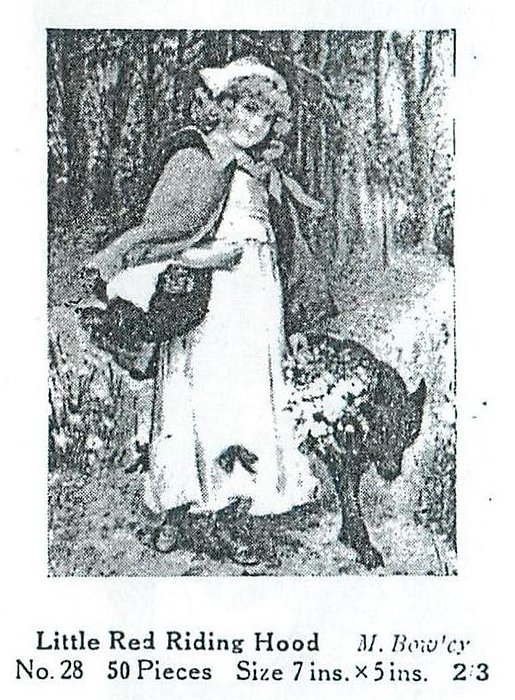
|
about 50 pieces, wooden, figurals, one missing piece and a poor replacement made, with box, described and listed in the catalogs and given the number 28, puzzle has a different artist signature than Bowley but the label and the catalogs list the artist as Bowley, the signature on the puzzle is Edith J. Andrews-see image
|
|
|
|
Zag-Zaw line of puzzles was first produced in 1909, most incorporate figurals or whimsies, sold in red, orange, or occasionally green boxes with labels on the side or bottom of the box, most without guide pictures. Initially cut non-interlocking but by 1930's became more so. Puzzles have a different cuts so that the same image will come in several versions which means that missing pieces can not be taken from other puzzles with the same image. The puzzle labels are often hand written and come with minor variations in titles and details. Some have a DESIGN catergory on the label. From my readings this refers to the style of cut, wavy lines, figurals, etc. See also Bob Armstrong's website on old jigsaw puzzles
|
H. BOWLEY (on label) puzzle is signed by Edith J. Andrews
|
|
5 x 7 in.
|
|
| ||||
| 69 |
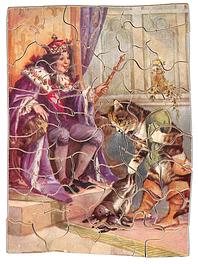
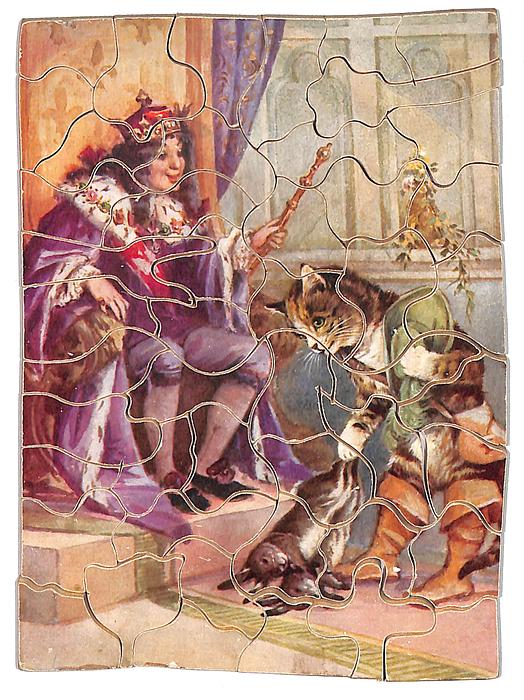
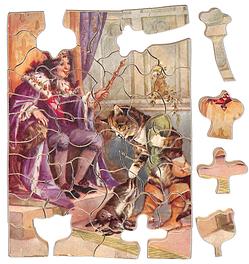
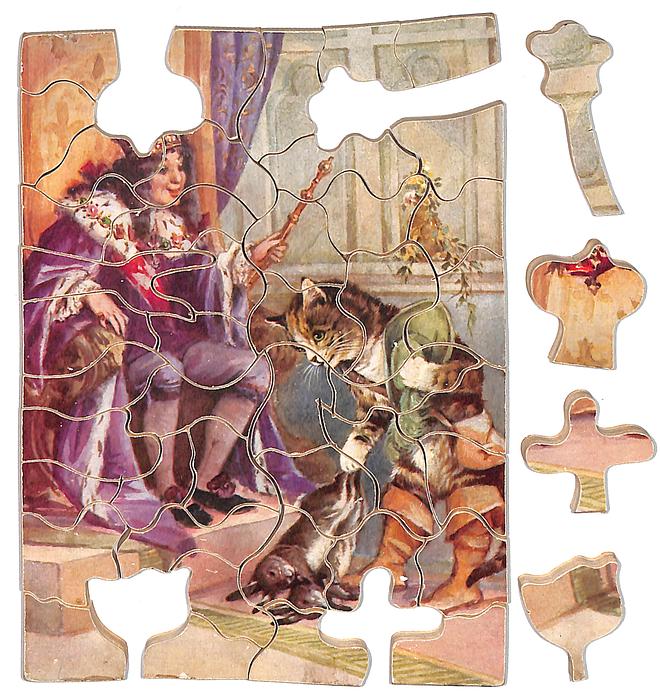
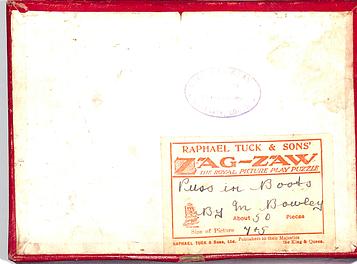
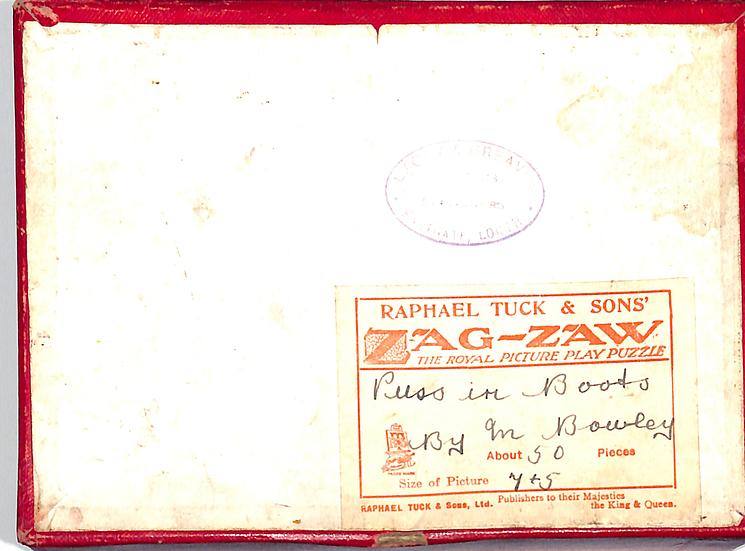
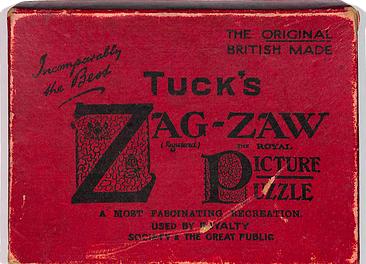
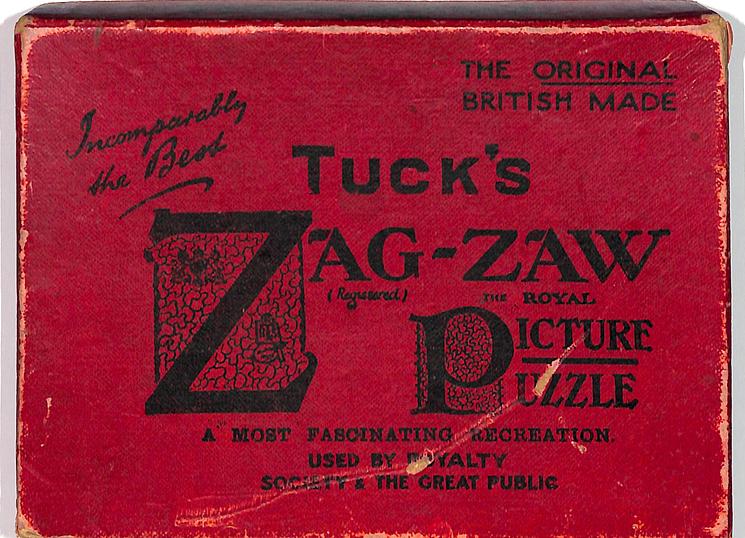
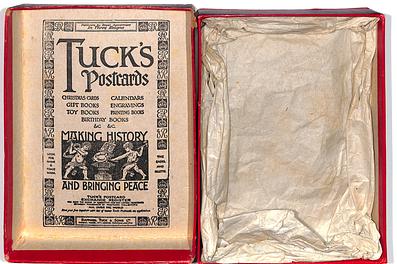

|
about 50 pieces, figurals, wooden, complete with box, push fit style, also comes labelled as puzzle number 905, pictured in catalog on pg 31, box is stamped LACEY & GREAVES, PRINTERS. STATIONERS, EASTGATE, LOUTH.
|
|
|
|
Zag-Zaw line of puzzles was first produced in 1909, most incorporate figurals or whimsies, sold in red, orange, or occasionally green boxes with labels on the side or bottom of the box, most without guide pictures. Initially cut non-interlocking but by 1930's became more so. Puzzles have a different cuts so that the same image will come in several versions which means that missing pieces can not be taken from other puzzles with the same image. The puzzle labels are often hand written and come with minor variations in titles and details. Some have a DESIGN catergory on the label. From my readings this refers to the style of cut, wavy lines, figurals, etc. See also Bob Armstrong's website on old jigsaw puzzles
|
M. BOWLEY
|
|
5 x 6 3/4 in.
|
|
| ||||
| 70 |
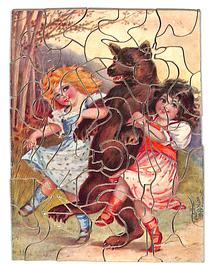
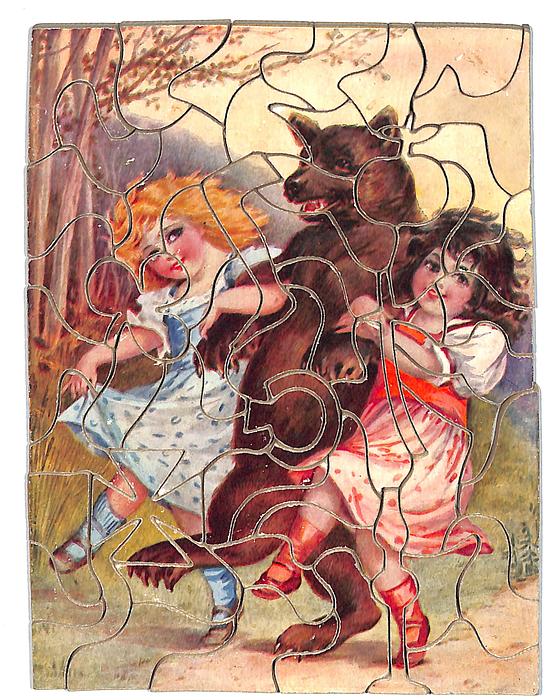

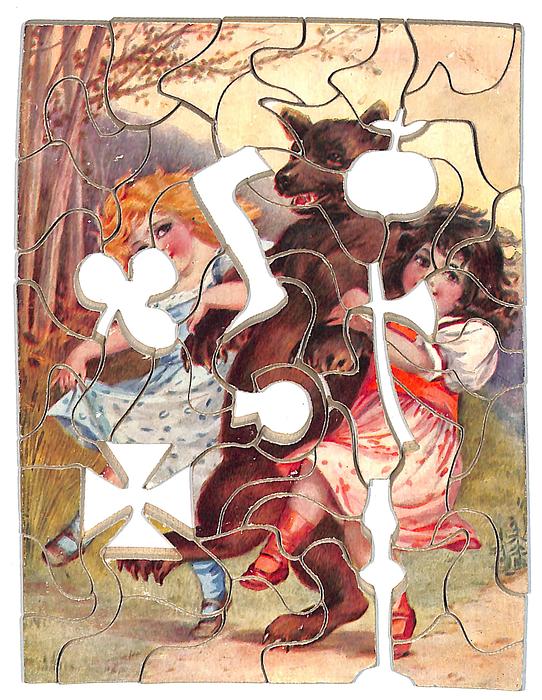
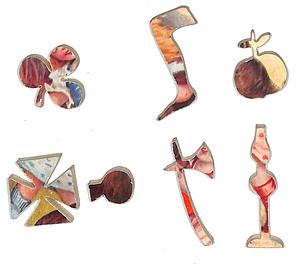
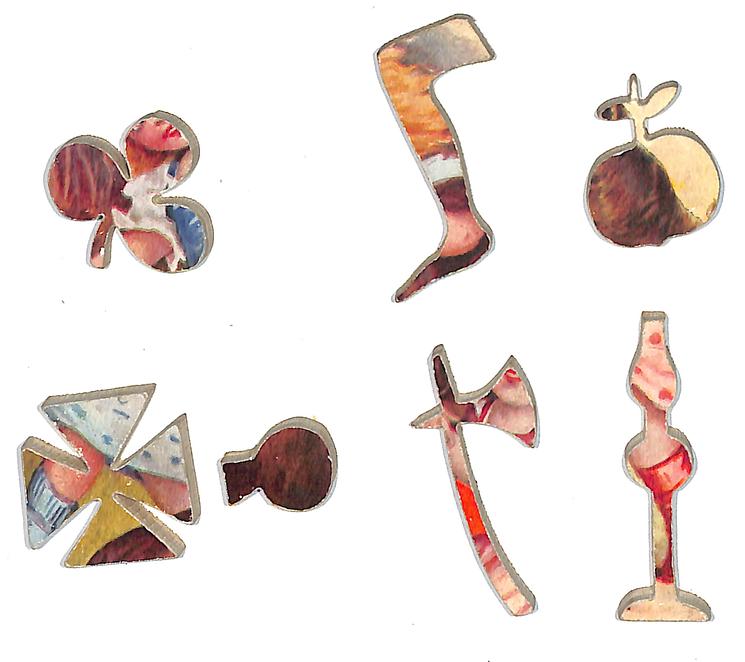


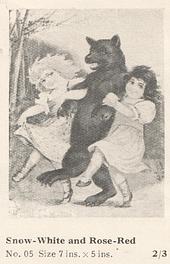
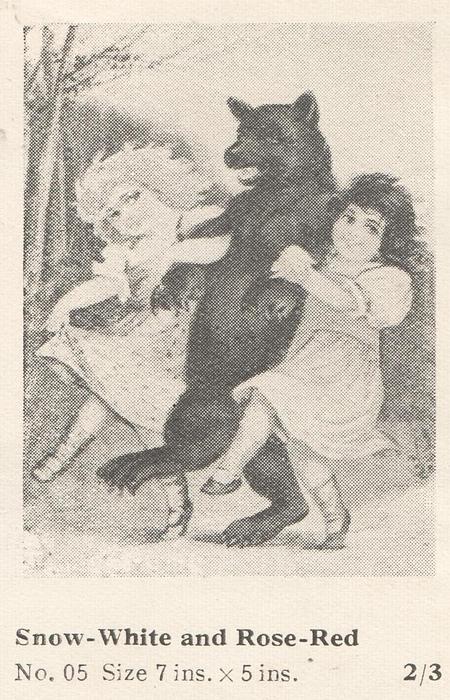
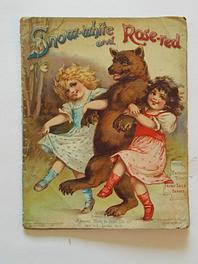
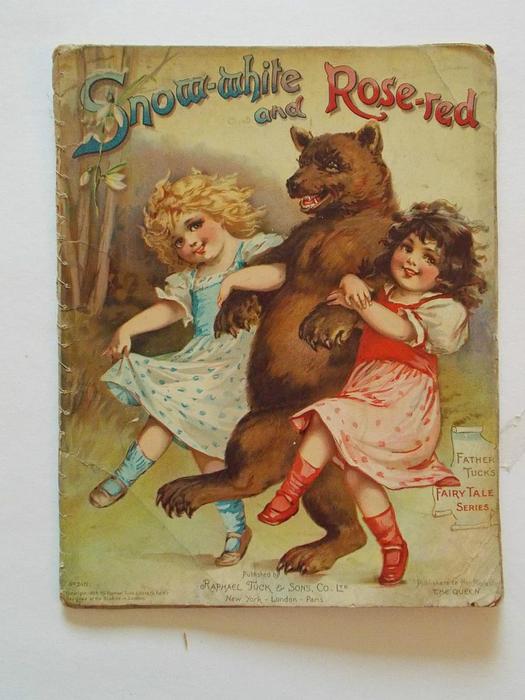
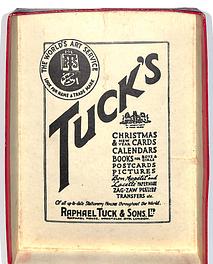

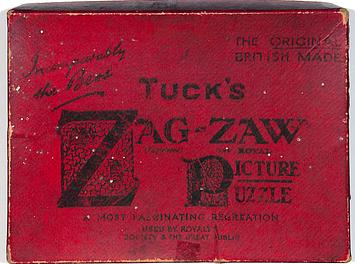
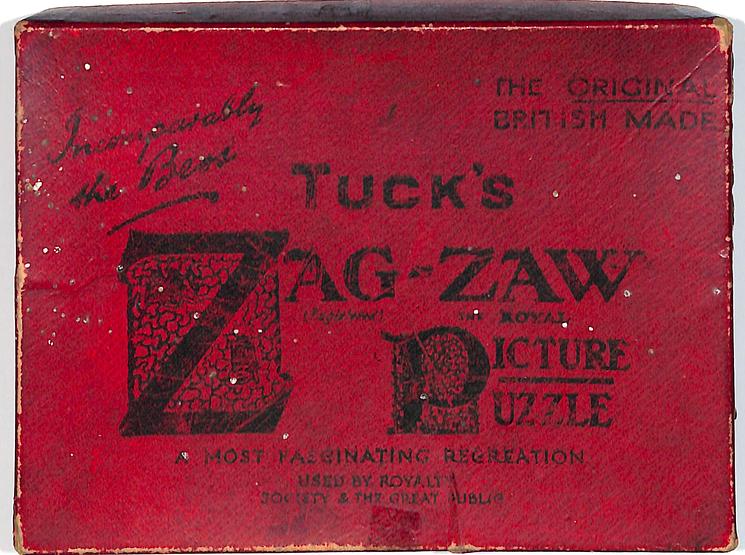
|
about 55 pieces, wooden, figurals, complete with box, push fit style, described and listed in catalogs as being No. 05 see image frontispiece and info from the book OLD FAIRY TALES 301 , also the cover image for another Tuck book
|
|
|
|
Zag-Zaw line of puzzles was first produced in 1909, most incorporate figurals or whimsies, sold in red, orange, or occasionally green boxes with labels on the side or bottom of the box, most without guide pictures. Initially cut non-interlocking but by 1930's became more so. Puzzles have a different cuts so that the same image will come in several versions which means that missing pieces can not be taken from other puzzles with the same image. The puzzle labels are often hand written and come with minor variations in titles and details. Some have a DESIGN catergory on the label. From my readings this refers to the style of cut, wavy lines, figurals, etc. See also Bob Armstrong's website on old jigsaw puzzles
|
FRANCES BRUNDAGE
|
|
5 x 7 in.
|
|
| ||||
| 71 |
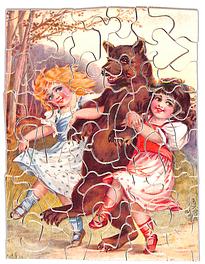
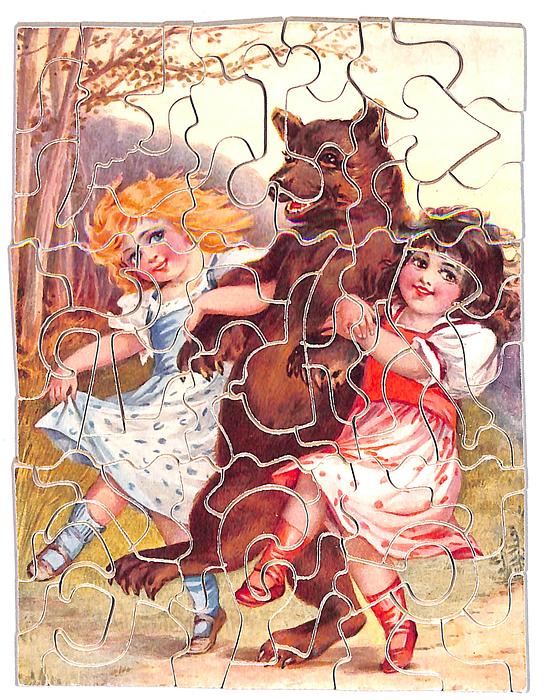
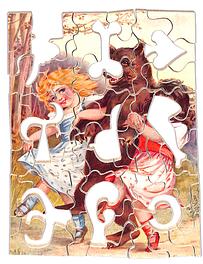
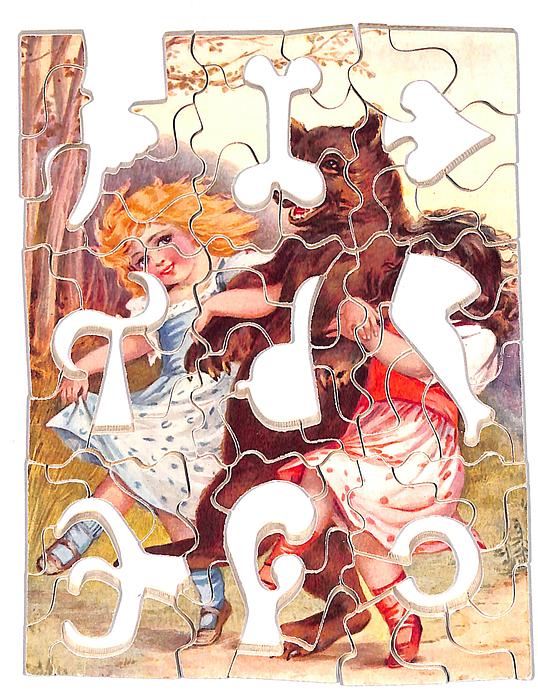
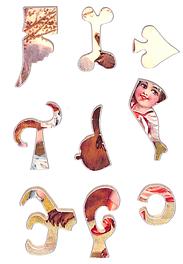
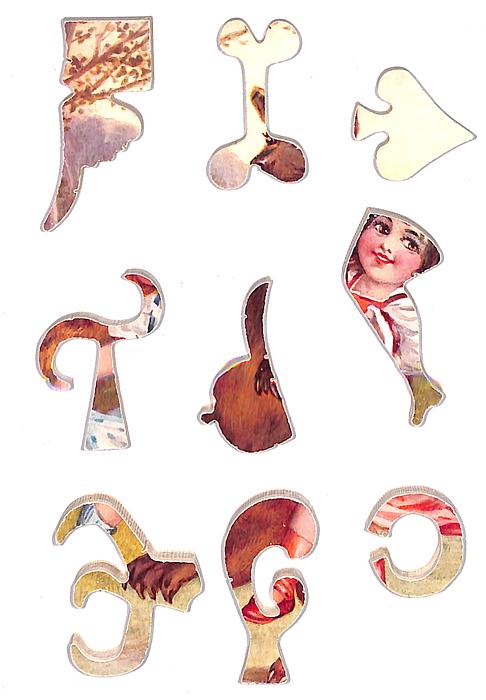
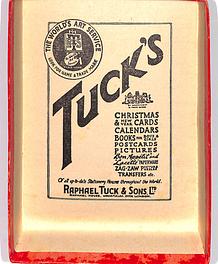
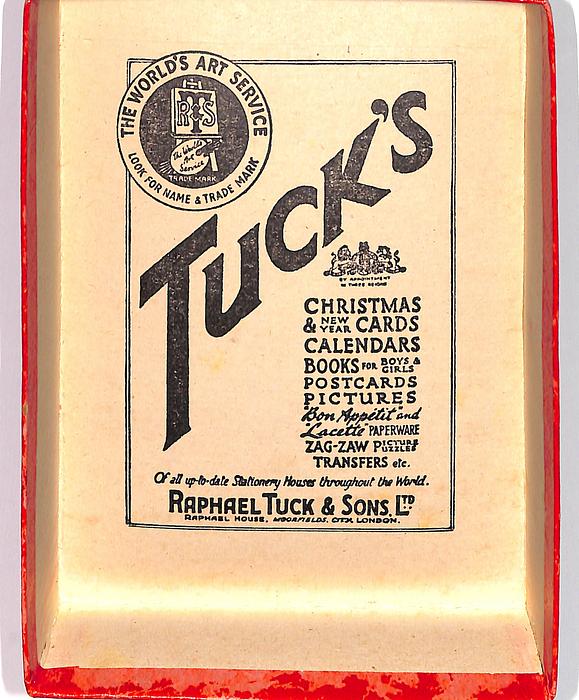
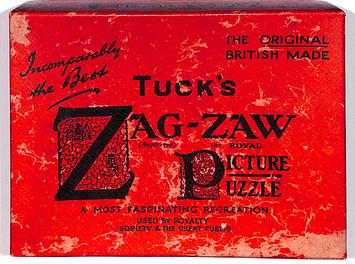
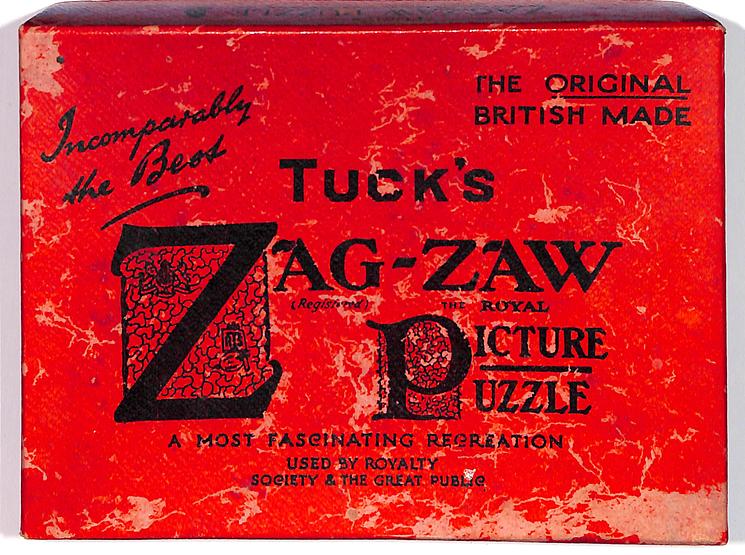
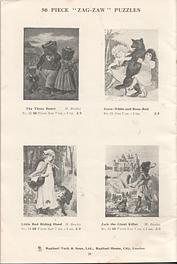
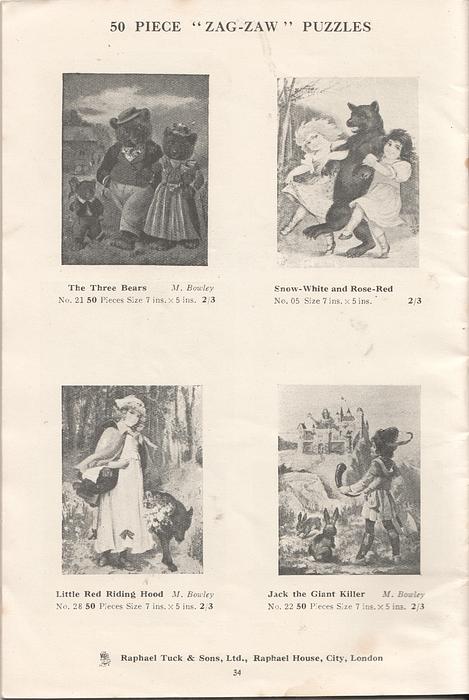
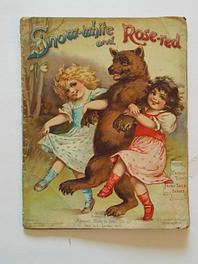
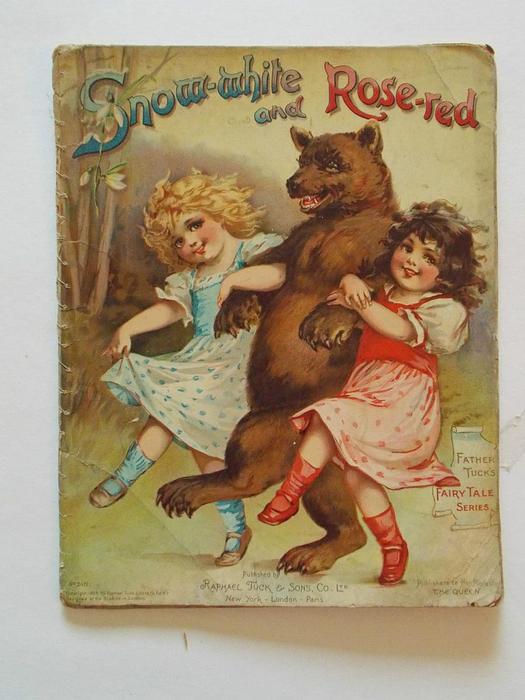
|
about 55 pieces, wooden, figurals, complete with box, push fit style, described and listed in catalogs as being No. 05 see image frontispiece and info from book OLD FAIRY TALES 301, also the cover image for another Tuck book
|
|
|
|
Zag-Zaw line of puzzles was first produced in 1909, most incorporate figurals or whimsies, sold in red, orange, or occasionally green boxes with labels on the side or bottom of the box, most without guide pictures. Initially cut non-interlocking but by 1930's became more so. Puzzles have a different cuts so that the same image will come in several versions which means that missing pieces can not be taken from other puzzles with the same image. The puzzle labels are often hand written and come with minor variations in titles and details. Some have a DESIGN catergory on the label. From my readings this refers to the style of cut, wavy lines, figurals, etc. See also Bob Armstrong's website on old jigsaw puzzles
|
FRANCES BRUNDAGE (from another puzzle with the same image)
|
|
5 x 6 1/2 in.
|
|
| ||||
| 72 |
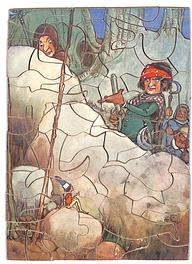

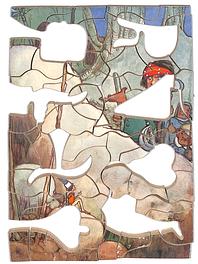
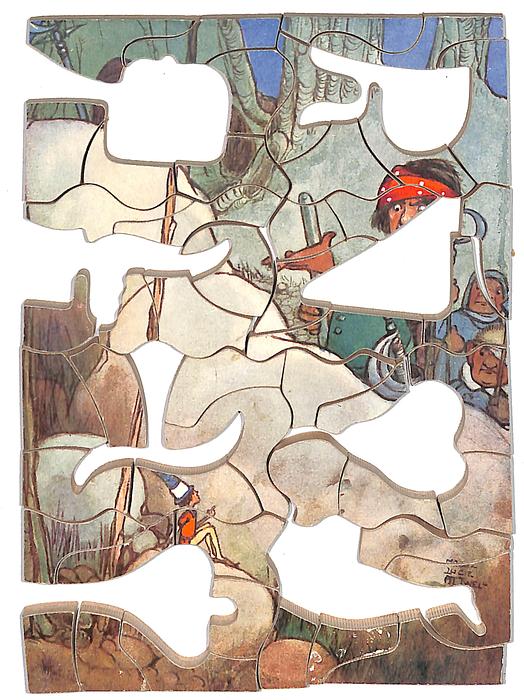
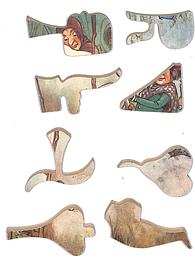

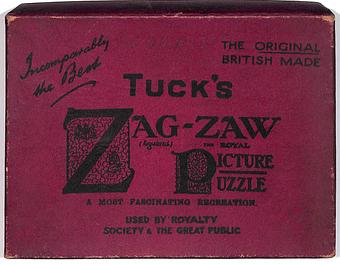
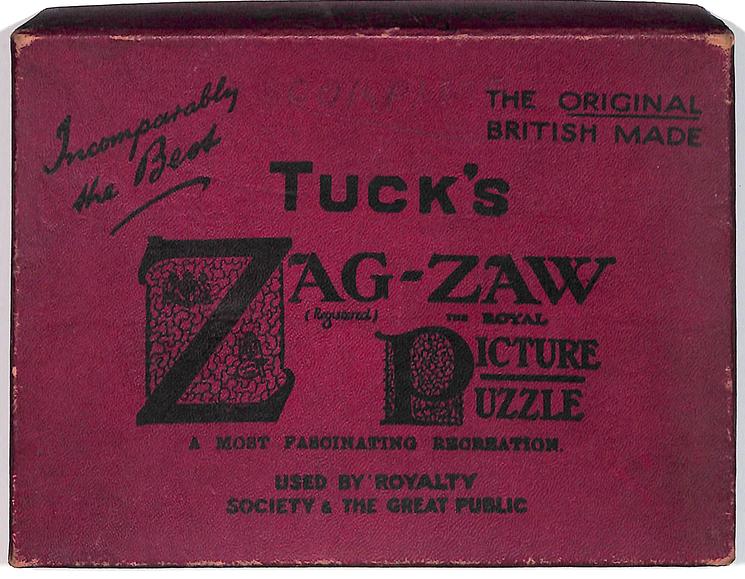
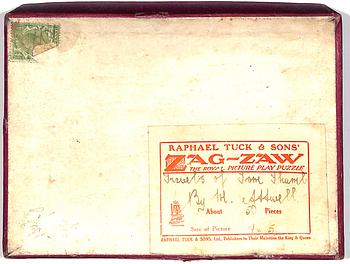
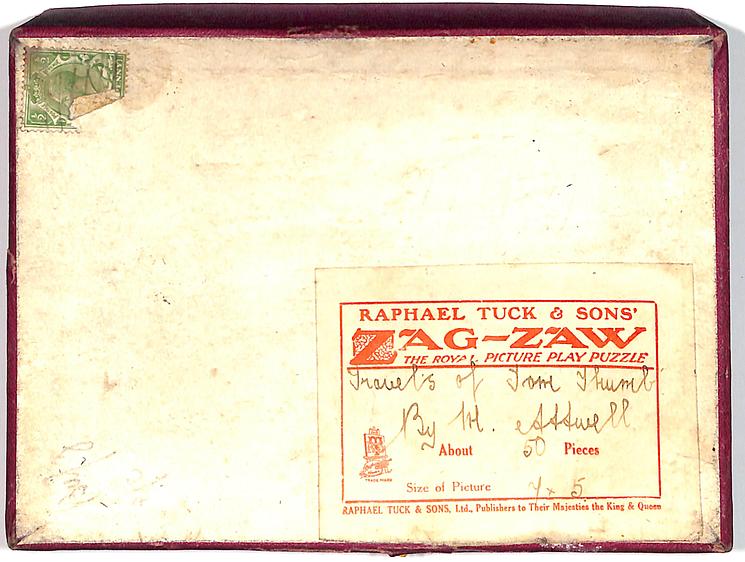
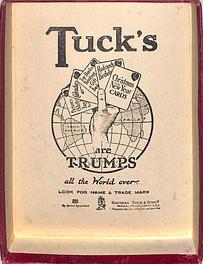

|
about 50 pieces, wooden, figurals, complete with box, push fit style
|
|
|
|
Zag-Zaw line of puzzles was first produced in 1909, most incorporate figurals or whimsies, sold in red, orange, or occasionally green boxes with labels on the side or bottom of the box, most without guide pictures. Initially cut non-interlocking but by 1930's became more so. Puzzles have a different cuts so that the same image will come in several versions which means that missing pieces can not be taken from other puzzles with the same image. The puzzle labels are often hand written and come with minor variations in titles and details. Some have a DESIGN catergory on the label. From my readings this refers to the style of cut, wavy lines, figurals, etc. See also Bob Armstrong's website on old jigsaw puzzles
|
M. L. ATTWELL (1879-1964)
|
|
5 x 6 3/4 in.
|
|
|